What to see in Lithuania: Introduction
Lithuania lures most visitors with its old towns, pristine nature, and religious buildings.
Historic cities are the Lithuania's prime destinations. The top three each have enough to see in a weekend break. Massive Vilnius Old Town is famous for its Baroque churches and capital atmosphere. Kaunas claims to be a treasure trove of early modern architecture, surrounded by one of Europe's largest fortification systems. Seaside Klaipėda boasts pretty beaches and lots of picturesque German and Lutheran Lithuanian heritage.

Natural sights in Lithuania are undoubtedly crowned by the Curonian Spit "Lithuanian Sahara". Vast pristine areas of forests, lakes, rivers and wooden villages in the other four National Parks may be less stunning, but equally rewarding, offering "close-to-nature" tourism opportunities.
Northern latitudes do not stop Lithuanian resorts from attracting hundreds of thousands locals and foreigners alike. Seaside resorts (calm Neringa and loud Palanga) are favored during the May-to-September season, while mineral spring resorts (primarilly Druskininkai) easily attract visitors all year round.
While the Lithuanian towns may seem dull at first, one can find historic or unique gems among them. Massive churches and historic manors are the prime sights, but a few particular towns offer more than that.
Catholic faith has defined Lithuanian culture, and many religious sights are especially impressive. Lithuanian wooden crosses are UNESCO-recognized art, with Hill of Crosses a world-famous sight. Smaller "forests of crosses", wayside chapels and cute-to-splendid churches adorn the entire country.
Lithuania stood in the middle of every major European war, leaving formidable castles, fortresses and installations. Trakai medieval castle reminds the Crusader-Pagan battles, Kaunas fortress is a World War 1 heritage while Samogitian forests hides Cold War nuclear missile silos, all this (and more) freely explorable.
While many smaller Lithuanian museums lack modernity and convenient opening times, the few major museums are worth a visit to understand Lithuania. Most popular are the ethnographic museums (of which Rumšiškės is the largest by far) and art museums. Thematic museums will appeal to those interested in a specific subject.
With an extremely diverse history, Lithuania is a great place for specific itineraries: seeking locations related to a particular ethnicity, religion, historical period, hobby... We offer Top 10 lists of sights and activities in or about Lithuania.
Cities of Lithuania: An Introduction
Long an agricultural society Lithuania nevertheless has several large cities. Two largest and most interesting among them are the capital city Vilnius (pop 550 000) and Kaunas (330 000), separated by mere 100 km of four-lane highway.
Both of them boast Old Towns with many churches (Baroque dominates the Vilnius skyline while Gothic belfries reign over Kaunas). Both also have extensive 19th-century additions where stately buildings and wide streets remind of the industrial revolution while Orthodox church domes tell of the fact that Russian Empire ruled Lithuania in that era. Unlike Vilnius, Kaunas also has major interwar districts as Kaunas was the seat of Lithuania’s parliament and government at the time.


Aušros Vartų steet in Vilnius Old Town. The Old Towns of Lithuanian cities has narrow streets and many churches. ©Augustinas Žemaitis.
Still, the historical importance of multicultural Vilnius is greater than that of Kaunas and only Vilnius Old Town is inscribed into the UNESCO World Heritage list.
Further away from the Lithuania’s heartland is Klaipėda (160 000), the country’s only seaport. Built and developed by German Teutonic knights this city is a part of Lithuania only since 1923 when Germany lost World War 1. Its German history was somewhat erased by post-1945 Soviet bulldozers, but there is still plenty to see in its 19th-century grid-layout old town.
Two remaining cities, Šiauliai (110 000) and Panevėžys (100 000) are located in the north. Both were heavily damaged in the World Wars and by the Soviet regime, therefore they are less architecturally appealing. However Šiauliai hosts the famous Hill of Crosses in its environs.
Almost every city of Lithuania has boroughs named “Senamiestis” (Old Town) and “Naujamiestis” (New Town). Senamiestis is typically the pre-1795 district while “Naujamiestis” is the area developed during the 19th-century Industrial revolution. Typically these two boroughs are where the most interesting places, as well as tourist facilities, are located. Together they are usually referred to as “Centras” (“Center” or “Downtown”). Downtowns traditionally are administrational and commercial hearts of Lithuanian cities. The latter fact was shaken recently by the construction of modern shopping malls further away. Many shops and restaurants relocated to these malls. Especially so in the smaller cities.


Junction of Basanavičiaus and Mindaugo street in the Vinius New Town. New Towns of the Lithuanian cities have larger buildings with elaborate historicist facades and wider streets. Building shown here is the Lithuanian Railways HQ (1903). With its 8 storeys it was once the city's tallest seccular building.
Take note that while Old Towns were urbanized in the 18th century or earlier not every building there is that old. While Vilnius and Kaunas indeed has many old buildings almost entire Klaipėda Old Town was rebuilt after a major fire in the 19th century while Šiauliai and Panevėžys downtowns suffered heavy war damage.
All the downtowns are surrounded by enormous Soviet boroughs of apartment blocks. Built to be self-sufficient these boroughs are now referred to as “sleeping districts” (miegamieji rajonai) as people come there only to rest. Nevertheless, these massive homes devoid of any architectural details house the majority of Lithuania’s urban population.
Inbetween the Soviet districts there are some pre-1940s suburbs, now absorbed into city-proper (Šnipiškės and Žvėrynas in Vilnius, Žaliakalnis and Panemunė in Kaunas). They are generally low-rise and largely wooden. While once almost every house there used to be owned by a single family now many of them are partitioned into several apartments. Some other similar districts were destroyed en-masse in 1950s-1980s to make way for Soviet apartment blocks.
After the restoration of independence in 1990, a de-urbanization process began with more and more people leaving the cramped Soviet apartments in favour of their own home in the suburbs. Beyond the Soviet apartment block areas of every city stand the genuine suburbs full of both large “private castles” (of early 1990s era with its cheap construction) and smaller homes akin to those in the West (dating to the 2000s and later). The proportion of the suburban population is however still much smaller than in some western societies.
SEE ALSO:
Getting around the cities of Lithuania.
Nature of Lithuania: Introduction
Lithuania is a lowland country. Its highest point is merely 294 m above sea level (in fact Lithuania is the world's largest country without locations above 300 m). The lack of mountains on the horizon is compensated by lush forests and countless lakes. There is lots of empty space and much of it is accessible as the law limits obstructions by land owners. With 55 people per square kilometer population density Lithuania is sparsely inhabited compared to the Western European heartland.
National parks
The most impressive scenery of every region is safeguarded in five national parks.
Curonian spit (Kuršių nerija) national park is rightfully the most famous one. This UNESCO-inscribed 98 km long narrow Baltic Sea peninsula, now spanned by two countries (Lithuania and Russia), is unique both naturally and culturally. The powerful dunes that used to bury entire fishermen villages were tamed by planting pine forests. Much of the both worlds remain, with endless possibilities for hiking, swimming, sailing and cycling as well as meeting some wild animals that roam the forests.


The sun is setting into the Baltic Sea over the dunes and pine forests of the Curonian Spit (picture from the top of Parnidis dune in Nida). ©Augustinas Žemaitis.
On the opposite shore of the Curonian Lagoon there is the annually flooded delta of Nemunas, Lithuania's main river. The lower valley of this river, full of castles, is also beautiful. Both lack the National park status but are popular among naturalists.
The national parks of Aukštaitija and Samogitia are well known for their lakes. They receive many visitors in summer. Lake Plateliai in the Samogitian NP is the largest lake completely in Lithuania while Tauragnas of Aukštaitijan NP - the deepest (62,5 m). Aukštaitija has many lakes outside the national park area.
Dzūkija National Park in the southeast is covered by a dense forest. Population density there is mere 2 people per square kilometer. It is a popular place to gather berries and mushrooms as well as kayaking in its streams. Nearby Čepkeliai swamp is a great representative of yet another typical feature of Lithuanian landscape.
The fifth national park, Trakai, is dedicated to the historically important Trakai town rather than natural scenery. However, its numerous lakes are also popular among tourists especially because of their easy reach from Vilnius (27 km).
Pleasure boats in Lake Galvė in Trakai Historical National Park. As many Lithuanian lakes, Galvė is surrounded by woods and plains. ©Augustinas Žemaitis.
Unlike some of their Western counterparts the Lithuanian national parks are not completely devoid of human habitation. Homes do exist - such as the wooden fishermen huts in the Curonian spit. Limitations on new construction mean that the villages within the park limits remain more authentic.
Flora, fauna and natural activities
Nature-lovers will not be left without activity outside the National Parks as well. There are possibilities for active tourism - e.g. walking a physically demanding route through a swamp. Angling is very popular, including the winter angling through special holes drilled in the ice layer (ice thickness needs to be checked as there are casualties every year). Foraging is another popular pastime with berry picking prevalent in summer and mushroom picking in autumn (city dwellers may ride 100 km in train for accessing the best forests).
While driving you may see wild animals, including rabbits, foxes, boars, deers, elks and squirells. These encounters are not very common however - but birds are. Pašiliai European bison sanctuary (near Panevėžys) and Ventė ornithology station (Nemunas delta) are good fauna-watching locations.
The most common trees are pines, spruces, birches and alders (in that order), though oaks are especially venerated.
The cultural landscape of Lithuanian countryside is a guaranteed sight, with its roadside chapels and elaborate wooden crosses (Lithuanian cross making is part of UNESCO world heritage).


Map of the main natural wonders of Lithuania. ©Augustinas Žemaitis.
Resorts of Lithuania
For such a short seashore (90 kilometers), Lithuania surely has much to offer for vacationers. Many different resort towns adorn its wide sandy beaches. In the north, there is the “flagship” Palanga resort with its loud music, funfairs, loads of entertainment and hordes of people. Even closer to the Latvian border stands the smaller Šventoji that has an image of a family resort. Klaipėda is a port city but its forested seaside districts do have a resort feel.
Half of the Lithuania's shore length is part of the Curonian Spit national park – a narrow peninsula of large moving sand dunes. They are now mostly covered by a pine forest, however, they are impressive both where they are forested and where they aren’t, as are the park's former fishing villages full of wooden homes and villas of centuries gone by. That is Neringa. This nature-oriented resort (or rather a long chain of ecological resorts), the most expensive in Lithuania, would not look out of place in any Western country.
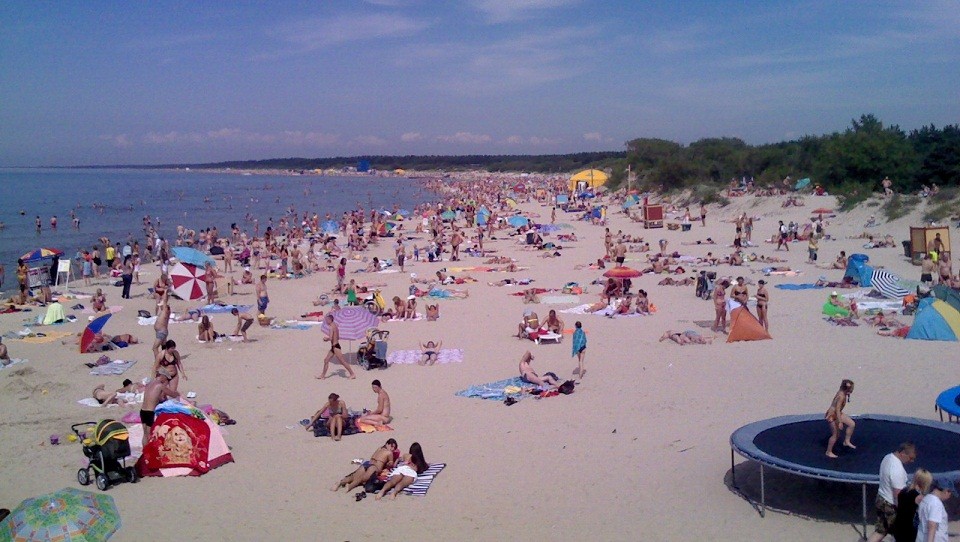

A crowded beach in Palanga on a hot and sunny summer day. The short Lithuanian coastline means many sunbathers per beach kilometer, but you may always find a more isolated place outside the major resorts. ©Augustinas Žemaitis.
What you won’t find on Lithuania’s shores are the monstrous Mediterranean-type hotels. With a shoreline so short, it is treasured and conserved. All beaches are public (free to use) and adjacent to the beaches, there are stretches of pine forests left for hiking and cycling (cars are largely banned there). Any real estate closer to the sea is extremely expensive and the lack of coastline is so intense that Lithuanians bought up almost every house in certain Latvian seaside villages just beyond the state boundary.
The only drawback is the architecturally unappealing large Soviet buildings, some of which were even built Neringa, let alone Palanga. They are built further from the coast but still stick out above the trees. These eyesores are compensated by new developments such as musical fountains or nice landscapping.
The Lithuanian summer sun is definitely hot and the dunes (a feature of many beaches) offer a wind coer for sunbathers, but the sea water stays cool, with 20 C water temperature considered especially warm. Lithuanians enjoy refreshing themselves in the sea after (or in-between) baking in the sun (on the beach itself in the hotter days and amidst the dunes on the cooler or windier days).
Although it is the seashore most Lithuanians visit in summer if they could, not every Lithuania’s resort is there. Another type of resorts are the spa towns which have been growing in popularity lately, frequented both by Lithuanians and foreign tourists alike.
Both Lithuanian seaside resorts and spa towns tend to be surrounded by pristine nature, especially forests. This is an image of Nida in the Curonian Spit. ©Augustinas Žemaitis.
The largest Lithuanian spa resort is Druskininkai, built in the 19th century on the banks of Nemunas river soon after mineral springs have been discovered there. It has expanded beyond spa in recent decades, adding an indoor skiing slope, a cable car, an adventure park and a museum of Soviet sculptures, among other attractions.
Birštonas is the second largest Lithuanian spa town that has also been recently successfully reinventing itself after years of stagnation, following the steps of Druskininkai.
All-in-all, the spa tourism that had a rather bad image until the 2000s (as the spas were considered rather outdated and oriented to serious patients only) is now a viable and modern year-round alternative to the seaside resorts, although the seaside resorts still dominate the Lithuanian summers.


A map of Lithuania's resorts. ©Augustinas Žemaitis.
Religious Sites in Lithuania: Introduction
Few countries could surpass Lithuania in size and lavishness of its churches if you take local population numbers into account. Furthermore, Lithuanian art of making elaborate crosses is inscribed in the UNESCO list of immaterial world heritage.
Nowhere this is felt more than in the Hill of Crosses (a unique-in-the-world site where millions of pilgrims have erected hundreds of thousands of crosses over more than a century). Arguably it is the most famous sight in Lithuania. A symbol of religion, anti-Soviet resistance and a powerful work of art all at once the Hill of Crosses impresses Christians and non-Christians alike.
View from one of the 'summits' of the Hill of Crosses. ©Augustinas Žemaitis.
Religiously however the center of Catholic life in Lithuania is in Šiluva. In this Samogitian village the Europe's first church-recognised apparition of Virgin Mary took place in 1608. The yearly celebrations (September 8th-16th) attract many thousands.
Almost every Lithuanian town and larger village have a Catholic church that feels far too massive for the settlement's population. This is because Catholicism always dominated the religious landscape (80%+ follows it) and there was no serious religious fragmentation for centuries. The older town and village churches (pre-1860) are typically smaller and wooden while the early 20th-century revivalist ones easily dwarf their surroundings in size. There is even a separate Lithuanian word meaning "Village with a Catholic church" (bažnytkaimis).
Rokiškis town church (1877) is considered among the best examples of Gothic Revival in Lithuania. ©Augustinas Žemaitis.
The most impressive collection of churches is in Vilnius Old Town where there are almost 30 such pearls of Gothic and Baroque. Most famous are St. Anne (for its exterior), Divine Mercy and the Gate of Dawn (both for miraculous paintings with worldwide following). Other boroughs of Vilnius also have a fair share of imposing churches (St. Peter and Paul being the most famous). So does the city of Kaunas.
In cities and towns one may also find Russian Orthodox churches. The largest and most important ones are once again in Vilnius where Holy Spirit church includes bodies of three Orthodox saints. Old Believer, Lutheran, Reformed Christian, Eastern Rite Catholic, Jewish, Muslim and Karaite religious buildings also exist, many of them predating the 20th century.
There is a long tradition in Lithuania of erecting crosses, chapels and chapel-posts (miniature chapels) at roadsides, cemeteries and courtyards. Countless of them were destroyed by the Soviet occupational power but many still remain. Some locations known as the holy places (šventvietė) became minor replicas of the Hill of Crosses.
See also: Religions in Lithuania, Christian holidays in Lithuania.


Map of main religious places and churches in Lithuania. Note: Lithuania has hundreds of beautiful churches and it is impossible to mark them all. ©Augustinas Žemaitis.
Towns of Lithuania: Introduction
The towns of Lithuania are centered around a church. It well might be a large historicist masterpiece of the early 20th century built after Russian Empire eased its restrictions on Catholic religious buildings. Some of these churches are so massive that they seem to have been transplanted from much larger cities. The tallest church spire in Lithuania is not in Vilnius or Kaunas, but in a small town of Anykščiai. Churches of Švėkšna, Palanga, Rietavas and others are also impressive.
Massive gothic revival Anykščiai St. Matthew church (1909) towers over the old wooden homes of this town of 11 000 inhabittants in Aukštaitija. ©Augustinas Žemaitis.
Some other towns still boast older (19th or 18th century) smaller churches, more often than not built of wood in a vernacular style. Then there are settlements with post-1990 churches that either replaced ones previously destroyed by fire or were newly built because these towns never had a church as they gained their importance during the atheist Soviet era.
Churches are typically located at the pre-WW2 market square. Multiple Catholic churches or market squares mark the former importance of the town. Some towns also have a 19th-century Russian Orthodox church and an abandoned synagogue. In Lithuania Minor, there are Lutheran churches next to the Catholic ones, while in the environs of Biržai and in Kėdainiai – Reformed Christian churches.
Another gem enjoyed by some towns is a manor, built by a local noble family some 100 or 200 years ago. Such manors are sometimes still surrounded by elaborate parks that were once crafted by famous French or Italian architects. Unfortunately, the Soviet nationalization drive and subsequent destruction hit the manors heavily, but today some of them are restored. Ones in Palanga and Plungė are especially beautiful. Some of the manors, as well as other buildings, hosts regional museums but few of those are worth visiting.
Meticulously repaired palace of the Plungė manor (Plungė, Samogitia). It was built in 1879 by the duke Oginskiai family. ©Augustinas Žemaitis.
The historical districts of almost every town used to be built of wood. Many buildings were destroyed by fire, others by the Soviets, therefore few old towns are intact today. The old wooden buildings were joined by Soviet functionalist shops, schools, clinics, bus stations and so-called cultural houses that were built on similar designs and layouts all across the Union. Small towns, just like cities, also received entire new districts of Soviet apartment blocks. The size of these buildings correlated with the size of the settlement, with residential buildings in villages not exceeding 2 stories, in small towns – 4 or 5. Streets of these districts are usually named after different jobs of the 20th century: “Melioratorių” (Irrigation specialists), “Mechanizatorių” (Mechanization specialists).
Soviets also built new detached homes. A popular series of these prefab buildings is known as “Alytus homes” as they used to be manufactured in Alytus.
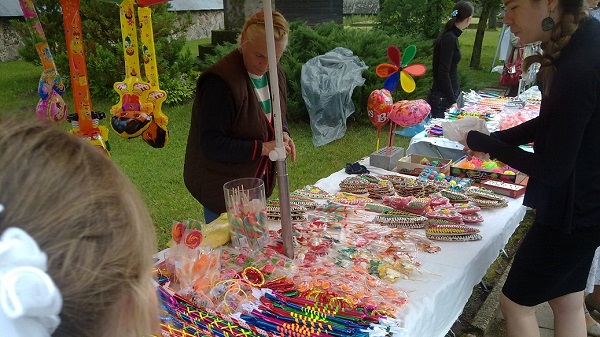

A local fair in Inturkė, Aukštaitija. Such events, known in Lithuanian as kermošius, typically correlate to locally important Christian feasts. Long sugar sweets are among the most popular goods sold.
The Soviet era districts of the towns today are somewhat run down due to low construction quality, urbanization, and emigration. These social tendencies meant that some of the towns changed relatively little since the restoration of independence (1990). However, most of them received one or more modern chain supermarkets. New family-owned restaurants and hotels were also opened in many towns to replace the gray Soviet ones although in some more remote places it may be difficult to find a place to eat on summer weekends when the marriages are celebrated.
For every rule there are exceptions, and these exceptions are the most interesting towns to visit. Kėdainiai is the only town to host a non-wooden pre-industrial Old Town. Ukmergė has a non-wooden historical district dating to the late 19th century.
Trakai (near Vilnius) and Biržai in the north are famous for their castles, a rare thing for the Lithuanian towns to have.
Resort towns of the 19th century are famous for elaborate wooden villas that were once summer retreats for their rich and noble owners. You may see such villas in Palanga, Druskininkai and Neringa.
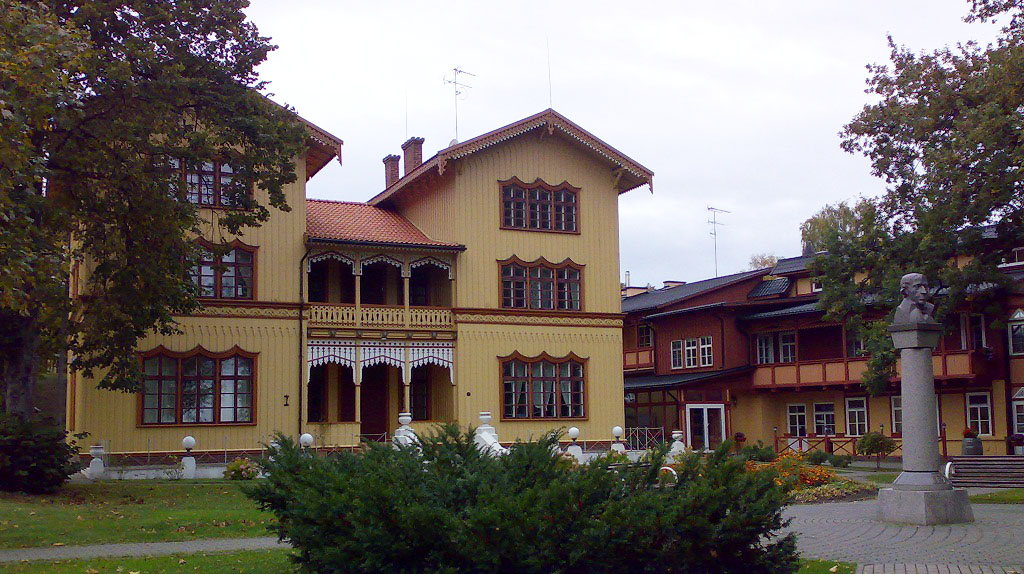

A wooden villa in Juodkrantė resort, Lithuania Minor region. ©Augustinas Žemaitis.
The Lithuania Minor area that was part of Germany for centuries has different architectural styles with red brick facades and wooden frame architecture. You may see this in Šilutė, Neringa, and smaller towns of the area.
A couple of Lithuania’s towns were conceived and built by the Soviets together with major power plants nearby. The more interesting among them is Visaginas, a 1970s-1980s town for a nearby nuclear plant. Elektrėnai is the other one.
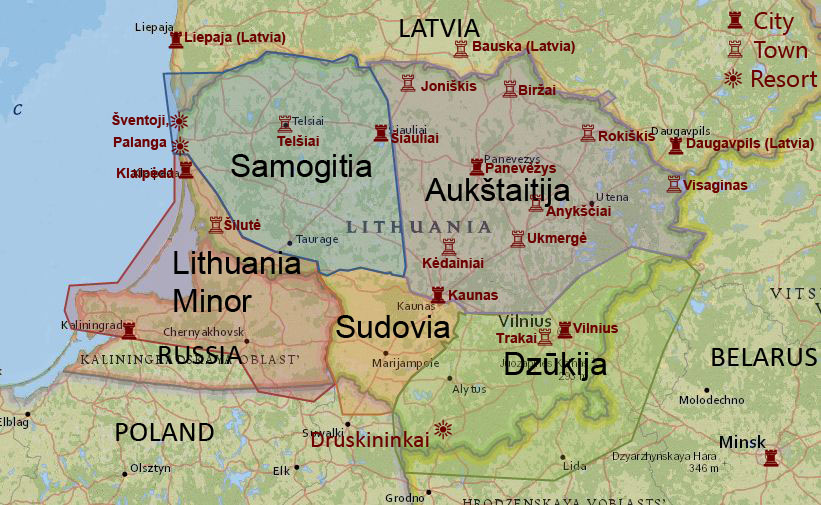

Map of the more interesting Lithuania's towns superimposed on Lithuanian regions. ©Augustinas Žemaitis.
Castles and fortresses in Lithuania
Traditionally the Lithuanian castles were wooden hillforts. None of them survived to this day, but many castle hills remain, some dating to the Bronze age. 5 of them are in Kernavė, the UNESCO-inscribed former capital (Aukštaitija region). There is an undergoing project to rebuild a wooden castle in Anykščiai (Aukštaitija).
Medieval brick castles were constructed in strategic locations along the rivers and near the political heartland of the country (Vilnius). The remains of the Vilnius and Kaunas castles are in the Old Towns and symbolically important. The reconstructed Trakai Island Castle is the most popular day-trip from Vilnius. Castle remains exist in Medininkai (East of Vilnius) and in Klaipėda. The Klaipėda castle constructed by the Teutonic knights, the arch-enemy of Lithuanians at the time. At this time entire cities were walled, but save for the few fragments the walls were destroyed in the 19th century. Some of the Grand Duchy of Lithuania castles are now in Belarus and Ukraine.
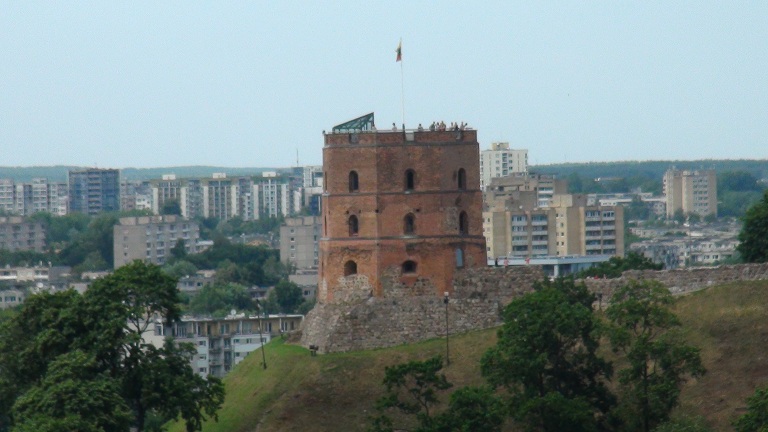

Gediminas Castle tower rises above Vilnius since the early 15th century. Now it serves as a small museum and a good vantage point, as well as the mast for the nation's primary flag. ©Augustinas Žemaitis.
The end of the Teutonic crusades in the 15th century permitted Lithuanian nobility to move from their castles to newly-built opulent manors. The richest ones covered tens of hectares and included many buildings and extensive gardens. Poorer nobles lived in wooden manors that differed from peasant homes only in size and architectural details. Some of the nobility palaces of 17th-19th centuries are built to resemble medieval castles. Three such castles are built near Nemunas west of Kaunas. The manors make an important part of the Lithuanian countryside as there are some 800 of them remaining, in different states of repair. The era of the manors ended with the land reform of 1923 and was completely struck down in 1944 with the nationalization and mass looting by the Soviet soldiers. As many of the manors eventually had a town built around them, see the page on towns of Lithuania to learn more about non-castle type manors.
The need for defense did not disappear with the increasing peace but artillery advances rendered castles obsolete. They have been replaced by bastion fortresses such as Biržai castle, at the time of construction among the most modern in Europe.
Industrial city growth replaced the idea of a single fortress to that of a massive ring of forts. In the 19th century the size of fortifications reached its pinnacle, with the Kaunas fortress absorbing the entire Lithuania's second largest city to such extent that the ruling Russian Imperial officials exclaimed: "There is no [longer a] Kaunas city. There is only Kaunas fortress". All the further city improvements were meant to serve the fortress and soldiers/officers made up 28% of city dwellers. Still surrounding the city the Kaunas fortress is one of the best-preserved examples of such 19th-century fortresses in the world.
6th fort of the Kaunas fortress. While largely abandoned, this fort retains much of its authenticity, its earth-strengthened semi-subterranean buildings still evoking memories of World War I and before. Some other installations and barracks of the Kaunas fortress are renovated and/or repurposed, but the fortress as a whole is simply too big to fully use. ©Augustinas Žemaitis.
20th-century mobile warfare and air force advances made such fortresses obsolete and they were supplanted by compact hidden installations, manned by several soldiers each. Such buildings may be found in woods near Vilnius (built by the Poles in the 1930s) and elsewhere (built by the Soviets). In the forests, you may also see modest secret bases of Lithuanian anti-Soviet partisans. Arguably the most interesting military installation of the 20th century is the underground Plokštinė Soviet nuclear missile base in Samogitia.
A makeshift partisan defensive installation deep in Lithuanian forests south of Panevėžys, Aukštaitija. Earthwork damp home is on the right, while on the left is a guardpost. Lithuanian partisans, now called the Forest Brothers, had to spend years in such circumstances waiting for the help from the West that didn't come. By mid-1950s partisans were largely killed by the Soviet forces, their bodies desecrated in main squares of nearby towns. ©Augustinas Žemaitis.


Map of castles, fortresses and major modern military installations in Lithuania. ©Augustinas Žemaitis.
Museums of Lithuania: Introduction
Lithuania has many museums all over the country.
The best few of them are a great introduction to the nation. Many others are just rooms full of poorly-explained mediocre-quality exhibits (with limited opening times and no English used). Learning more about a particular museum is, therefore, crucial before visiting.
In general, large urban museums tend to be better, but the countryside has quite a few gems as well. Private museums (of which there are few) tend to be better presented than the public ones. Among the latter, those renovated after independence are the best options.
Most Lithuanian museums fall into five types and here we suggest the best museums of each type:
Ethnographic museums
Ethnographic museums showcase pre-modern traditions, tools, arts and crafts of a Lithuanian village. Some of them are outdoors and include reconstructed pre-WW1 homes.
Rumšiškės Ethnographic Museum is the most famous among them – 195 ha in area it is also among the largest museums of the world. Entire villages from every Lithuanian historic region have been built here: together with churches, mills, artisans and some farm animals. Traditional holidays are celebrated the traditional way.
A typical farmstead in Rumšiškės museum. ©Augustinas Žemaitis.
Much smaller regional alternatives are Horse Museum in Anykščiai (Aukštaitija region) that specializes in re-enacting pre-modern crafts and giving information on horses and Telšiai Countryside Museum, which is more static.
Prussian-Yotvingian settlement in Southern Sudovia is a reimagination of a prehistoric village that puts atmosphere before historical authenticity and is more of a sight than a museum. Pakruojis manor living museum (weekend-only) is the only one to concentrate on nobility rather than the peasantry.
Art museums
Art museums usually feature either works of a single Lithuanian artist or a collection of art particular period(s)/style(s).
The best period collections are National Art Gallery (Lithuanian 20th century paintings) in Vilnius and Grūtas park (Soviet propaganda sculptures which every artist was forced to create). Excelling in their fields are Museum of Archeology in Kernavė (Baltic prehistoric art) and Museum of religious art in Vilnius (pre-modern religious art) - although for religious art Vilnius churches may be a better fare to see it in authentic context.
Among the one-artist museums M. K. Čiurlionis art gallery in Kaunas is the most important one by far, as Čiurlionis's symbolist otherworldly style is almost synonymous with "famous Lithuanian paintings". Other artists that have their own museums are mostly Lithuanians who once escaped the Soviet occupation and bequeathed their works to Lithuania after independence: Vytautas Kasiulis (uber-colorful style paintings, Vilnius), Kazys Varnelis (optical art, Vilnius), Kazimieras Žoromskis (optical impressionism, Vilnius), Antanas Mončys (sculptures made of a single slab of wood, Palanga).
Works by Lithuanian-American Kazimieras Žoromskis in his eponymous museum. Photo ©Augustinas Žemaitis.
Catch-all regional museums
Catch-all regional museums typically cover the local archeological finds, flora and fauna, manor riches and peasants tools, customs and pictures of recent history. Most regions aren’t that unique so visiting many such museums is not advisable. Opt for the ones that are located in buildings worth visiting (e.g. manors) and renovated.
National Museum in the Vilnius Old Town covers entire Lithuania. Not as great as the name suggests it is still a nice introduction.
Alka museum of Samogitia in Telšiai had its collection amassed before World War 2 and Soviet destruction, resulting in a great quality.
Kretinga museum’s lack of exhibits are compensated by a nice manor location with an indoor garden restaurant.
Interior of the restored Kretinga manor (now museum). ©Augustinas Žemaitis.
Museums of genocide and resistance
Museums of genocide and resistance serve as a repository for images, stories, letters of Soviet Genocide victims and fighters against the regime. Many such museums have been established all over Lithuania in the 1990s as memorial halls to the locals who perished. In the small towns, their opening times are especially sporadic. Opt for visiting the major such museums in Vilnius instead as their collections are the most extensive and best suited to non-Lithuanians.
The most famous are the Museum of Genocide Victims in a former HQ of KGB Soviet secret service where many have been tortured and murdered, Vilnius New Town. Interior is as it was left by KGB.
Tuskulėnai Museum built over a KGB mass murder site is restored and boasts a nice modern memorial.
Interior of Tuskulėnai Memorial. The symbolic round central room (right) is surrounded by a corridor full of numbered urns with the remains of Tuskulėnai victims. ©Augustinas Žemaitis.
9th fort in Kaunas covers both the Soviet and Nazi German genocides as its site was used for murders by both regimes.
Thematic museums
Thematic museums cover a single topic and its relation to Lithuania. Museums on topics that are the “essence” of Lithuania are especially worth visiting. Other museums are interesting only if they are related to your hobby.
The most “Lithuanian” thematic museums are those of Amber (inside Palanga manor palace), Lithuanian history (inside Trakai island castle), Grand Duchy of Lithuania (inside Vilnius Grand Dukes Palace), Lithuanian folk musical instruments (in Kaunas Old Town), Basketball (in Joniškis).
Museum of the Seas in Klaipėda is likely the most extensive among the rest (it includes shipping history info and a kind of sea animal zoo). Museum of Ethnocosmology has the most ingenious building, but it may be more of an artwork than a museum with few exhibits inside. Cold War museum has the most appropriate location (inside a real Soviet missile silo).
Lookout/telescope tower in the museum of ethnocosmology. ©Augustinas Žemaitis.
Some other thematic museums: Railways, Energy and Technology, Military Vehicles (all in Vilnius), Communications, Sport, War, Aviation, Cold War spy equipment (all in Kaunas).
Memorial museums
Lithuania has a large number of Memorial museums, each dedicated to a single famous person or family. Typically they are located in that person’s former home and exhibit their original furniture and things. A foreigner is unlikely to know most of these people but a chance to feel the spirit of a particular era that is still present in many such museums can be rewarding. Vilnius and Kaunas have the most of those with some half of them requiring an advance arrangement to visit.
A memorial museum of interwar opera singer K. Petrauskas in Kaunas. ©Augustinas Žemaitis.
Museum opening times and discounts
Most museums are open for 5-6 days a week. If there is one non-working day it is usually either Sunday or Monday, if there are two such days then the second one is either Saturday or Tuesday.
Major and private museums tend to stay open late into the evening while small and regional museums may close at ~17:00.
Discounts are available for children, students, and old-age pensioners.
English inscriptions are available in the renovated and private museums, but unrenovated museums may have just Lithuanian or Lithuanian-Russian ones.
Popular itineraries in Lithuania
Lithuania is a colorful country that may be enjoyed differently by various people. Here we offer thematic itineraries, each consisting of 10 best locations and/or activities in Lithuania related to a specific topic, need or interest.
Top 10 sights in Lithuania
1.Vilnius city, a vibrant capital with its extensive old town and countless baroque church spires.
2.The Curonian Spit, a 98 km long narrow Baltic Sea peninsula covered by sandy dunes and pine forests where fishermen huts and upscale hotels exist side-by-side.
3.Hill of Crosses, a unique-in-the-world place where millions of people erected millions of these Christian symbols.
4.Kaunas city, a boomtown in 1880s-1930s when it served firstly as major Russian fortress and then as the seat of Lithuania's government. Kaunas medieval district is more intact than that of Vilnius and the 19th-century military buildings still surround the city center, while the Baroque Pažaislis monastery crowns the suburbs.
5.Trakai town with its impressive island castle, many lakes and Karaim ethnic minority.
6.Rumšiškės open-air museum inspired by Stockholm's Skansen. Old wooden buildings have been moved here from all over Lithuania and the main ethnic holidays are celebrated the traditional way.
7.Plokštinė Soviet missile base, a unique opportunity to enter the shafts where nuclear missiles once waited to be launched.
8.Druskininkai 19th century mineral springs resort, revitalised by a large indoor alpine skiing arena and a water entertainment park. Grūtas park, where all the demolished Soviet statues ended up, is not far away.
9.Palanga seaside resort with its lively Basanavičiaus street. But the calmness is never far away in a large manor park, centered at a palace that now houses a major amber museum.
10.Visaginas town built by Soviets in 1980s for nuclear power plant workers - but the plant has since closed down. This somewhat eerie town is what Pripyat (near Chernobyl) would have looked if not for the disaster.
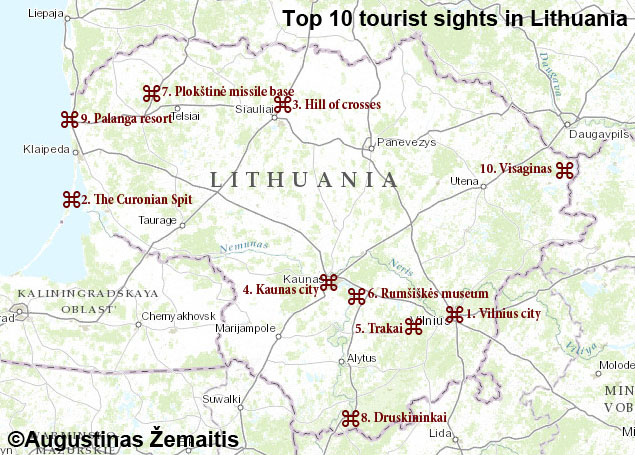

Map of Lithuanian ethnographic regions. Numbers mark the top 10 sights. See below for explanations.
See also additional specialized top 10s based on:
*Personal interests.
*Ethnicity.
*Religion.
*Historical period.
*Special needs.
*Transportation used for travelling.
We also have weekend break ideas for Lithuanian cities.


